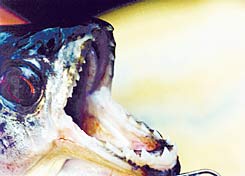The red-bellied piranha, the fish that lives in the Amazon River, enjoys a reputation as a ferocious and terrifying animal, partly because of its sharp teeth, with which it quickly kills its victim. These reputations may not be justified

piranha "A normal fish with big teeth, that's all," said the researcher
They are from f-h-dim
The red-bellied piranha, the fish that lives in the Amazon River, enjoys a reputation as a ferocious and terrifying animal, partly because of its sharp teeth, with which it quickly kills its victim. However, according to Dr. Anne Magoran of the University of St. Andrews in Scotland, it is very possible that the reputation given to the piranha is not justified. The piranha, the researcher claims, may actually be a soft-bodied fish that moves in groups for protection and not for hunting.
Dr. Magoran and her colleague Dr. Helder Queiroz began to study piranhas in the Mamirava reserve in Brazil, with the aim of learning how these fish hunt. "When we started, our assumption, which is accepted in research, was that they move in packs as a means of cooperative hunting," said Dr. Magoran. If this were the case, the researchers would expect to see certain fish form relationships with other fish according to the principle of mutual altruism - I will do you a favor, and you will return the favor. "However, we found almost no evidence that the same fish stay together for a long time," said the researcher.
The researchers also knew that piranhas prey on other animals, including cormorants, dolphins and caimans. They noticed that when the fish were put in the tank their breathing rate, indicating a state of stress, became fast, as if they were afraid of being attacked. "They were very stressed," said Dr. Magoran. "We had to drive very carefully and cover the tank so they wouldn't see anything."
The researchers conducted an experiment in which they put the fish in tanks in groups of two to eight. As they reported in the journal "Biology Letters", they discovered that the smaller the group, the faster the breathing rate of the fish. In another experiment, in which the researchers conducted a simulation of a cormorant attack, they discovered that in the fish that were in the tank in the larger groups, the breathing rate returned to its normal state more quickly compared to the fish that were in the tank in small groups. That is, the fish felt safer in large schools.
Dr. Magoran said that in the habitat of the piranhas, forests rich in water, the fish may benefit from natural protection in the form of branches and vegetation. Therefore, the size of the school of fish is of little importance. However, the researchers learned something about the true nature of the piranha fish. "Exposure that these fish are cruel, that are not afraid of the desert - does not stand the test of reality," said Dr. Magoran. "The piranhas are ordinary fish with big teeth, that's all."
